#Ptolemaic Kingdom
Explore tagged Tumblr posts
Text
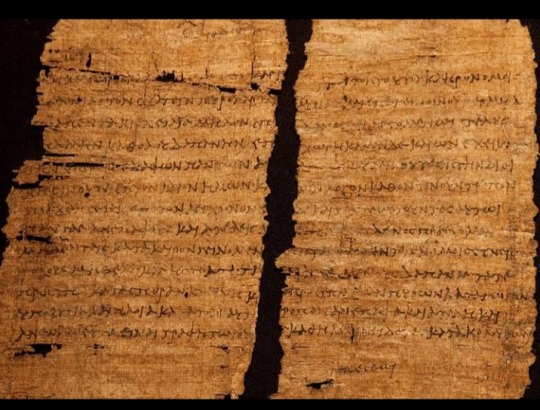
This papyrus signed by Cleopatra grants tax exemption from sales of imported wine to the Roman businessman Publius Canidius, a friend of Mark Antony.
At the bottom, in a rare example of her handwriting, Cleopatra herself added the Greek word "ginesthoi," which means "make it happen."
—
Cleopatra VII Thea Philopator (70/69 BC – 10 August 30 BC) was Queen of the Ptolemaic Kingdom of Egypt from 51 to 30 BC, and its last active ruler.
#Cleopatra#Mark Antony#Publius Canidius#Cleopatra VII Thea Philopator#Ptolemaic Kingdom#Egypt#Ancient Egypt
666 notes
·
View notes
Text

Minhopete: That's right! And no one knows he's here yet, thanks to me! Minhopete: I skillfully tricked the rat into sneaking off! Tutanblot: Ah! Brilliant idea!

Tutanblot: Who suggested it to you?
Il Principe delle Sabbie (2023)
#lmao!#poor pete!#so underestimated! xD#pete pegleg#phantom blot#alex bertani#francesco vacca#giuseppe facciotto#period piece#ptolemaic kingdom#topolino magazine#disney gang#disney mice#italian disney comics#from this week topolino
27 notes
·
View notes
Text

Isis ptolemaica en terracota policromada. Siglos IV-I a. C.
#archaeology#art#isis#goddess#ancient egypt#ptolemaic kingdom#ptolemaic isis#artwork#sculpture#ptolemaic egypt#ptolemaic dynasty#arte#arqueología#diosa#mitología egipcia#antiguo egipto#egyptian mythology#escultura#mythology
5 notes
·
View notes
Text
Mummified crocodile, 332-30 B.C. Priests took great care with these wrappings, modeling the head, nostrils and eyes in linen and covering the body in a crisscross pattern secured by linen thread. The remains inside look less impressive: a flattened crocodile, possibly a hatchling, covered with resin.
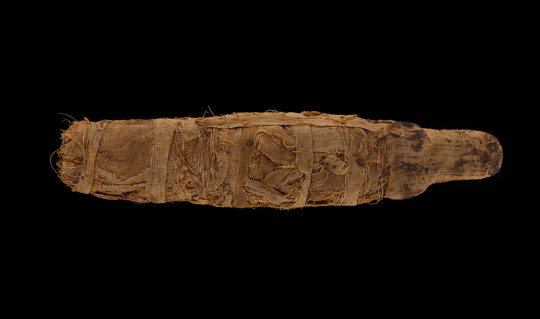

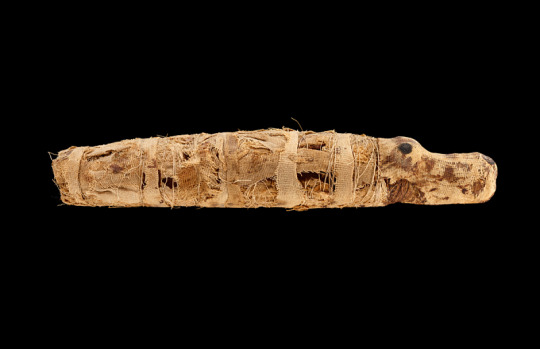

~ Mummified crocodile.
Date: 332-30 B.C.
Place of origin: Qena, Upper Egypt
#history#animals#burials#egypt#ancient egypt#ptolemaic kingdom#upper egypt#thebes#qena governorate#qena#mummies#crocodiles
567 notes
·
View notes
Text
The fact that these 2 are more than a thousand years apart yet they are both considered "Ancient Egyptian" is kinda crazy


15 notes
·
View notes
Text

The Pharos of Alexandria by Roy Krenkel
#lighthouse of alexandria#pharos#alexandria#lighthouse#art#roy krenkel#ptolemaic#kingdom#ancient greek#ancient egypt#ancient world#egypt#monument#antiquity#history#architecture#seven wonders#lighthouses#structure#mediterranean#ship
339 notes
·
View notes
Text

Artfight attack of @thejabberwookie ‘s character, Ven!
This was a lot of fun to do because there was a lot of design involved. I had a lot of help from my mom, who used to be a tour guide (and my little sister, who was also a guide and is just generally into our history :‘D ).
It’s a mishmash of New Kingdom and Ptolemaic Egypt (because New Kingdom outfits go hard).
---
You can find me most places as FriskaFriskito or Friskishdrawings!
For donation commissions for Palestine click here
#artfight 2024#team seafoam#ancient egypt#vampire#requests and gift art#artfight#character art#new kingdom#ptolemaic egypt#also I just think the tiny aten hands are funny#sun god
19 notes
·
View notes
Photo
Title: Receipt for payment of beer, [between 41 and 68]
Description: 1 fragment of 1 leaf : papyrus ; 14.2 x 5.9 cm.
Language: Greek, Ancient (to 1453)
Notes: Manuscript consisting of 4 partial lines of text, on the verso only, the recto being blank. Also available in an electronic version. In Greek.
Provenance: Euhemeria, Egypt.
Harvard Semitic Museum (accession no. 3760), the gift of the Egypt Exploration Fund, 1904.
Deposited by the Harvard Semitic Museum, ca. 1959.

Papyrus receipt for purchase of beer, ca. 50 AD.
MS Gr SM3760
Houghton Library, Harvard University
#history#classics#languages#trade#food and drink#alcohol#egypt#ancient egypt#ptolemaic kingdom#euhemeria#qasr el banat#beer#ancient greek
166 notes
·
View notes
Text
Gazing into her ice water as though it were a crystal, Theda told dreamily of her former life as Queen of the Nile and flashed a 2,000-year-old ring given to her by a 110-year-old sheik. “I felt the blood of the Ptolemys coursing through my veins,” sh emoted. “I know that I am a reincarnation of Cleopatra. It is not a mere theory in my mind. I have positive knowledge that such is the case. I live Cleopatra, I breathe Cleopatra, I am Cleopatra!”
— EVE GOLDEN ⚜️ Vamp: The Rise and Fall of Theda Bara, (1998)
#American#Eve Golden#Vamp: The Rise and Fall of Theda Bara#Theda Bara#(1998)#Cleopatra#The Ptolemaic Kingdom of Egypt
12 notes
·
View notes
Text

𝔗𝔥𝔢 𝔏𝔦𝔳𝔦𝔫𝔤 𝔐𝔲𝔪𝔪𝔶 𝔟𝔶 𝔉𝔯𝔞𝔫𝔨 𝔅𝔯𝔲𝔫𝔫𝔢𝔯
#Frank Brunner#The Living Mummy#art#artwork#mummy#Queen of the Ptolemaic Kingdom of Egypt#painting#illustration
39 notes
·
View notes
Text



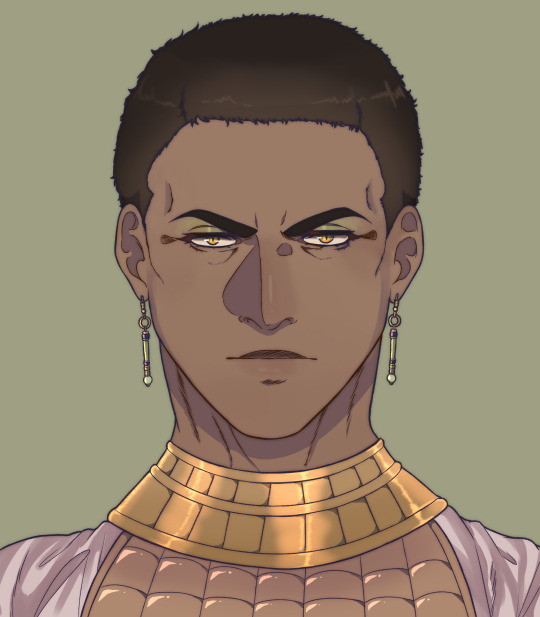

Introducing the main characters from the webcomic I'm developing on Ancient Egypt: Lucius, Djet, Iaret (Chloe), Khawy and Sempronia!
#webcomic#ancient history#pharaonic egypt#roman egypt#republican rome#imperial rome#ptolemaic egypt#new kingdom#late period#ancient egypt#ancient rome#vampires#my art#tfotds#the followers of the divine snake#smswart#thefollowersart#lucius#djet#iaret/chloe#khawy#sempronia
6 notes
·
View notes
Text

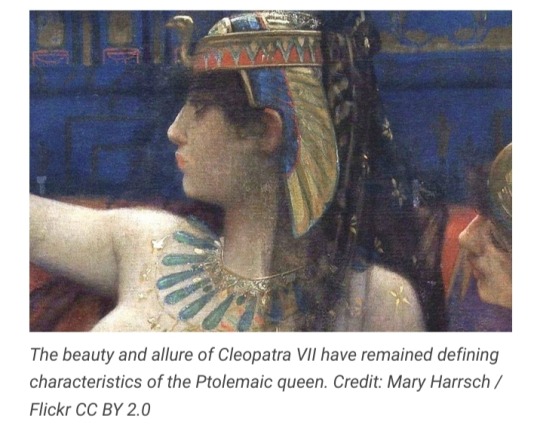
A significant part of Cleopatra VII Philopator’s enduring reputation is as one of history’s most famous femme fatales, renowned for her beauty and wit which attracted not one, but two of the Roman Republic’s most powerful men.
Whether or not this popular characterization of Cleopatra is historically accurate, her reputation has led many to wonder whether she had any particular beauty secrets that she used to ensure Julius Caesar and Mark Anthony.
The historical record does provide some clues as to how the Ptolemaic dynasty’s most famous ruler presented herself, from hairstyles to clothing, and even makeup.
Although we cannot be entirely certain how she presented herself, there are enough historical details to piece together a reasonable picture of how Cleopatra might have presented herself.
Was Cleopatra really a beauty?
As the old adage goes, “Beauty is in the eye of the beholder.”
As far as the ancient sources are concerned, the question of Cleopatra’s beauty raised mixed responses, with some ascribing an irresistible physical appearance to her and others attributing her allure more to her intellect and charm.
For example, Cassius Dio (164 to c. 235 AD), an ancient Greek historian, described Cleopatra as “a woman of surpassing beauty.”
During the first meeting between Julius Caesar and Cleopatra, Cassius Dio wrote:
"Caesar, upon seeing her and hearing her speak a few words, was so completely captivated that the Roman general acquiesced immediately to Cleopatra’s requests."
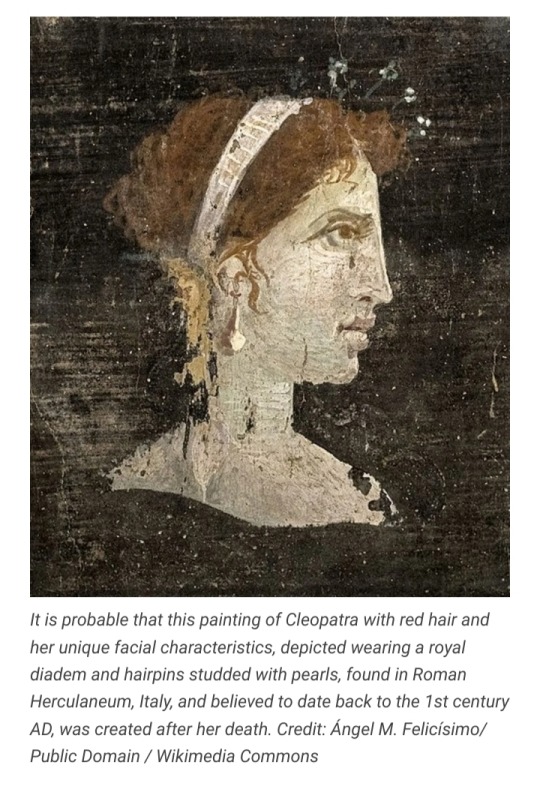
Plutarch (c.46 to c.119 AD) also briefly commented on the Ptolemaic queen’s appearance in his Life of Mark Anthony.
Contrary to Cassius Dio, Plutarch did not reckon Cleopatra’s beauty to be particularly noteworthy but instead praised her intelligence and character.
“Her beauty, so we are told, was not itself outstanding; it did not immediately strike those who saw her; yet being with her had an inescapable hold; when talking with her, she was persuasive, and the character which surrounded her whole manner in company had a force to it,” wrote the Greek historian and philosopher.
Hair and makeup
In the few surviving marble busts of Cleopatra, she is depicted wearing her hair tied at the back in a bun.
Historians like Paul Edmund Stanwick refer to this as a “melon hairstyle.”
Coinage depicting the queen shows her wearing the same hairstyle.
Depictions of Cleopatra with this hairstyle also show her wearing a diadem, a symbol of royal power adopted by many Hellenistic rulers who succeeded Alexander the Great as the masters of the divided fragments of his empire.

Professor Diana Kleiner of Yale University has identified two more hairstyles worn by Cleopatra.
One of these hairstyles emulated those worn by Macedonian queens, which is unsurprising given Cleopatra’s lineage.
To achieve this style, the hair was carefully divided into individual curls, which were typically swept away from the face and elegantly gathered into a bun positioned at the back.
According to Professor Keline, it may have been worn during travel.
The other hairstyle was “the usual Egyptian wigged headdress that had its origins in Pharaonic times.”
In this case, the main point of attention would have been the headdress rather than the hair itself, with a rearing cobra made of precious metal proudly displayed.
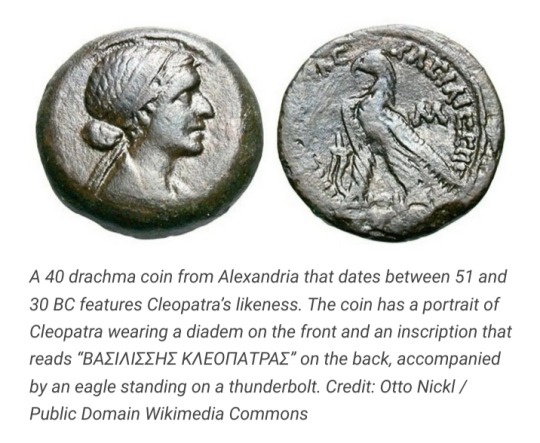
Professor Kleiner explains that “Cleopatra appears to have worn different coiffures in different circumstances, playing to her audience, so to speak, in life and in art.”
It would have been important for her to present herself in the Hellenistic fashion to the Greek elites who held the most senior positions in Ptolemaic Egypt, but also in traditional Egyptian fashions for her ruler to appear legitimate to a native Egyptian audience.
Regarding the Ptolemaic queen’s makeup choices, she would darken her eyebrows and enhance her eyeliner using black kohl, creating an elongated look.
The application of deep blue eyeshadow extended gracefully up to her brows, further accentuating her eyes.
Additionally, Cleopatra embraced the fashionable trend of adorning her hands with intricate henna patterns, a popular practice during that era in Alexandria.
Clothing
Cleopatra wore a variety of Greek, Egyptian, and Roman outfits intended to accentuate her beauty.
The selection of these styles would have been dependent on the contexts in which the queen appeared, as it was important for her to present herself accordingly to her friends, foes and subjects.
One of the styles she wore combined Greek and Egyptian aesthetic sensibilities and is seen depicted on sculptures of other Ptolemaic queens.
This style consisted of a sheer dress, likely of a semi-transparent material, which left the bare breasts exposed in a manner popular amongst native Egyptian women.
The depictions of other Ptolemaic queens wearing this style are consistent with the writings of the Roman poet Lucan, who claimed that she wore a transparent dress that exposed her breasts, likely made of Chinese silk.
Lucan also described the jewelry she wore, writing that “her baleful beauty inordinately painted, covered with Red Sea pearls, a fortune in her hair and around her neck, weighed down with jewelry.”
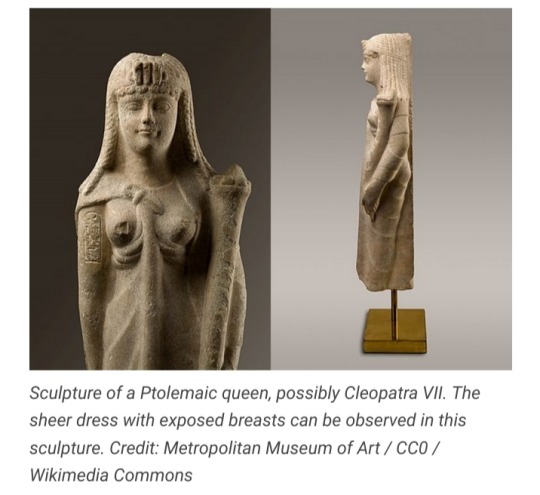
NOTE:
Cleopatra VII Thea Philopator (70/69 BC – 10 August 30 BC) was Queen of the Ptolemaic Kingdom of Egypt from 51 to 30 BC and its last active ruler.
A member of the Ptolemaic dynasty, she was a descendant of its founder, Ptolemy I Soter, a Macedonian Greek general and companion of Alexander the Great.
#Cleopatra VII Thea Philopator#Cleopatra#Queen of the Ptolemaic Kingdom of Egypt#Ptolemaic Dynasty#Ancient Egypt#Ptolemy I Soter#Ancient Macedonians#Julius Caesar#Mark Anthony#Cassius Dio#Plutarch#melon hairstyle#Egyptian fashion#Lucan#Ptolemaic Queen#Hellenistic fashion#Alexandria#Beauty Secrets of Cleopatra
53 notes
·
View notes
Text
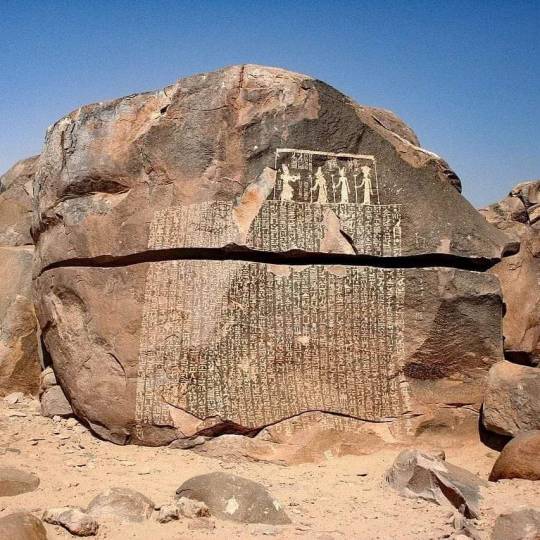
The Famine Stela is an ancient inscription in Egyptian hieroglyphs found on Sehel Island near Aswan, Egypt. It recounts a seven-year drought and famine during the reign of Pharaoh Djoser of the Third Dynasty (circa 2686 BC - 2613 BC). King Ptolemy V is believed to have inscribed it during the Ptolemaic Kingdom around 205-180 BC. The top part of the stela depicts Djoser offering to Egyptian deities while expressing concern about the drought's impact on his people. Initially, it was connected to the biblical story of a seven-year famine in Genesis 41, but further research has revealed similar stories in Mesopotamian legends and the Gilgamesh Epic, suggesting a common theme in ancient Near Eastern cultures. Another Egyptian tale of prolonged drought is also found in the "Book of the Temple."
792 notes
·
View notes
Text
More Ancient Egyptian Art Vocabulary

for your next poem/story
Double crown - the crowns of Upper and Lower Egypt worn together
Dynasty - a series of rulers descending within a family; following the Ptolemaic historian Manetho, ancient Egyptian history is divided into thirty dynasties
Faience - a powdered quartz paste, which is modeled or molded and fired; it is either self-glazed or made with applied glaze
False door - a panel in the form of a niched doorway through which the deceased could receive offerings
Gesso - a mixture of whiting and glue often used to prepare a surface for painting
Harakhty - “Horus of the horizon,” the god of the rising sun, depicted as a falcon or a falcon-headed human crowned by a sun disk
Hathor - a goddess sometimes depicted as a cow or with cow’s horns and ears; associated with joy, music, and love
Heh - god of millions of years, of eternity
Hieratic - handwritten counterpart to the hieroglyphic script, developed in the Old Kingdom mainly for writing on papyrus; written from right to left
Hieroglyph - a Greek word meaning “sacred symbol.” In Egypt, one of some seven hundred signs used in writing (considerably more if one counts signs used exclusively in the Old Kingdom and the periods after the New Kingdom). “Hieroglyphs” refers to the signs themselves; “hieroglyphic script” is Egyptian writing. (Calling the signs “hieroglyphics” is incorrect.)
Horus - ancient sky god in the form of a falcon, embodiment of the divine powers of the living king; son of Osiris and Isis
Ideogram - (sense sign) a hieroglyph signifying the actual object depicted or a closely connected notion
Isis - wife of Osiris, mother of Horus, the divine magician because of her extraordinary powers, divine mourner of the dead; her name is written with the hieroglyphic sign for “throne,” which she wears on her headdress
Ka - life force; the hieroglyphic sign is a pair of extended arms
Maat - right order and justice established by the gods, personified by the goddess Maat, who wears an ostrich feather on her head or is represented by the ostrich feather itself
Magic rod - a squared or rectangular object carved with symbols, such as felines, crocodiles, protective wedjat eyes, and baboons tending lamps, that Egyptians may have believed helped the sun reappear each day from the chaos of night. These rods were placed in tombs to guarantee a similar rebirth to the deceased.
Mastaba - a type of Egyptian tomb having a rectangular superstructure with exterior walls slightly slanting inward as they rise; contains chapels, chambers, and a shaft leading to an underground burial
Mortuary temple - a temple erected and endowed by a king where he could receive offerings in perpetuity after his death
Mut - “mother”: worshiped as the consort of Amun; shown as a vulture or as a woman wearing the double crown
Myrrh - a fragrant aromatic plant gum used in making perfume, unguents, and incense
Source ⚜ More: Word Lists
#ancient egypt#art#terminology#word list#writeblr#writing inspiration#spilled ink#writing reference#dark academia#creative writing#light academia#literature#writers on tumblr#poets on tumblr#writing prompt#poetry#writing resources
93 notes
·
View notes
Text
From card: "Wrapped in linen, features painted. 03-12-1987 lent to Memphis Pink Palace Museum; Loan returned Dec 9 1987."
From NMNH Exhibit Hall "Eternal Life in Ancient Egypt" label for this artifact, 2011: Mummified head of a cat, 332-30 B.C. The elaborately painted and modeled ears on the squished face of this cat mummy give it the look of a real cat. The head contains a cat skull, and it was originally part of a complete cat mummy.




~ Head Of Mummified Cat.
Date: 332-30 B.C.
Place of origin: Egypt
621 notes
·
View notes
Photo

Ancient Egyptian Architecture
Ancient Egyptian Architecture is often associated closely with the pyramids of Giza but was actually quite diverse, taking a number of forms in the construction of administrative buildings, temples, tombs, palaces, and the private homes of nobility and commoner. Ornamentation of these various structures also varied according to their purpose and the resources of the builder.
Even so, the pyramids are the most recognizable symbol of ancient Egypt. Even though other civilizations, such as the Maya or the Chinese, also employed this form, the pyramid in the modern day is synonymous in most people's minds with Egypt. The pyramids at Giza remain impressive monuments thousands of years after they were built and the knowledge and skill required to construct them was gathered over the many centuries prior to their construction.
Yet the pyramids are not the apex of ancient Egyptian architecture; they are only among the earliest and best known expressions of a culture which would go on to create buildings, monuments, and temples just as intriguing.
6,000 Years of History
Ancient Egyptian history begins prior to the Predynastic Period (c. 6000 - 3150 BCE) and continues through the end of the Ptolemaic Dynasty (323 - 30 BCE). Artifacts and evidence of overgrazing of cattle, in the area now known as the Sahara Desert, date human habitation in the area to c. 8000 BCE. The Early Dynastic Period in Egypt (c. 3150 - 2613 BCE) built upon the knowledge of those who had gone before and Predynastic art and architecture was improved on.
The first pyramid in Egypt, Djoser's Step Pyramid at Saqqara, comes from the end of this Early Dynastic Period and a comparison of this monument and its surrounding complex with the mastaba tombs of earlier centuries show how far the Egyptians had advanced in their understanding of architectural design and construction. Equally impressive, however, is the link between these great monuments and those which came after them.
The pyramids at Giza date from the Old Kingdom (c. 2613 - 2181 BCE) and represent the pinnacle of talent and skill acquired at that time. Ancient Egyptian history, however, still had a long and illustrious path before it and as the pyramid form was abandoned the Egyptians focused their attention on temples. Many of these whose ruins are still extant, such as the temple complex of Amun-Ra at Karnak, inspire as much genuine awe as the pyramids at Giza but all of them, however great or modest, show an attention to detail and an awareness of aesthetic beauty and practical functionality which makes them masterpieces of architecture. These structures still resonate in the present day because they were conceived, designed, and raised to tell an eternal story which they still relate to everyone who visits the sites.
Continue reading...
87 notes
·
View notes